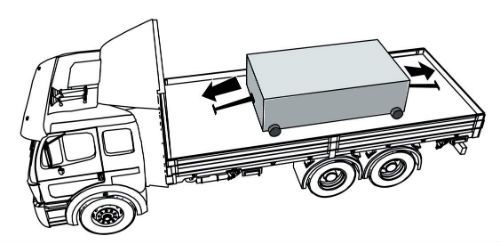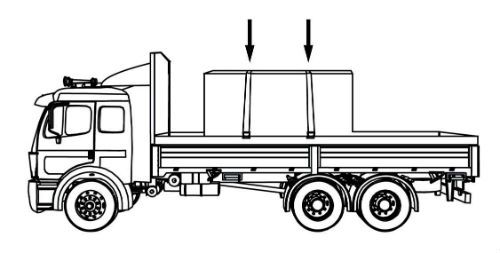CDL Practice Tests: Flatbed Cargo Securement
Choose A Section:
Go!When securing building materials, how many tiedowns are required for top tier bundles longer than 5 ft?
- It depends on weight
- 2
- 0
- 1
Tiedowns over the top tier of bundles with a minimum of 2 tiedowns over each top bundle longer than 1.52 m (5 ft).
What is the minimum amount of rearward force that a cargo securement system must withstand?
- 50% of cargo weight
- 20% of cargo weight
- 100% of cargo weight
- 80% of cargo weight
Each cargo securement system must be able to withstand a minimum amount of force in each direction.
- Forward Force = 80% of cargo weight when braking while driving straight ahead.
- Rearward Force = 50% of cargo weight when accelerating, shifting gears while climbing a hill, or braking in reverse.
- Sideways Force = 50% of cargo weight when turning, changing lanes, or braking while turning.
-
Upward Force = 20% of cargo weight when traveling over bumps in the road or cresting a hill.
- This requirement is satisfied when the cargo is "Fully Contained."
A tiedown is defined as:
- A strip of material that may be used to unitize articles and is tensioned and clamped or crimped back upon itself. (same as "Strapping")
- A structure, device, or another substantial article placed against or around an article to prevent horizontal movement of the article.
- A rail along the side of a vehicle that protects the side of the vehicle from impacts.
- A combination of securing devices which form an assembly that attaches cargo to, or restrains cargo on, a vehicle or trailer, and is attached to anchor point(s).
Tiedown:
A combination of securing devices which form an assembly that attaches cargo to, or restrains cargo on, a vehicle or trailer, and is attached to anchor point(s).
When securing a single metal coil with eyes vertical:
- Attach at least one tiedown over eye of coil from side-to-side.
- Attach at least one tiedown diagonally across eye of coil from right side of vehicle to left side of vehicle.
- These are all requirements.
- Attach at least one tiedown diagonally across eye of coil from left side of vehicle to right side of vehicle.
To prevent the coil from tipping forward, rearward, and sideways, arrange tiedowns to include the following:
- Attach at least one tiedown diagonally across eye of coil from left side of vehicle to right side of vehicle.
- Attach at least one tiedown diagonally across eye of coil from right side of vehicle to left side of vehicle.
- Attach at least one tiedown over eye of coil from side-to-side.
When securing building materials, spacer requirements include all of the following except:
- The length of spacers must provide support to all pieces in the bottom row of the bundle.
- If spacers are comprised of layers of material, the layers must be unitized or fastened together to ensure that the spacer performs as a single piece of material.
- The height of each spacer must be equal or greater than the width.
- Spacers must provide good interlayer friction.
Spacer Requirements
- The length of spacers must provide support to all pieces in the bottom row of the bundle.
- The width of each spacer must be equal or greater than the height.
- Spacers must provide good interlayer friction.
- If spacers are comprised of layers of material, the layers must be unitized or fastened together to ensure that the spacer performs as a single piece of material.
The North American Cargo Securement Standard cover vehicles weighing:
- 26,001 lbs
- Less than 10,000 lbs
- Over 10,000 lbs
- Over 4,500 lbs
North American Cargo Securement Standard
What does the Standard cover? (Section 1.1)
- Commercial vehicles (including a combination of vehicles) that are operated on a highway and have a gross vehicle rating over 4,500 kg (10,000 lb.)
Vehicles
'Blocking' is defined as:
- A tapered or wedge-shaped piece used to secure round articles against rolling.
- A rail along the side of a vehicle that protects the side of the vehicle from impacts.
- A structure, device, or another substantial article placed against or around an article to prevent horizontal movement of the article.
- A vertical barrier across the front of the deck of a vehicle to prevent forward movement of cargo.
Blocking:
A structure, device, or another substantial article placed against or around an article to prevent horizontal movement of the article.
When securing paper rolls with eyes horizontal, which of the following should be used to secure the rear-most roll?
- Secure roll against rear doors.
- Secure blocking against rear doors.
- All of these are acceptable
- Wedges or chocks secured by some means in addition to friction.

Note: Chocks, Wedges, or Blocking Securing the Front or Rear Roll - Hold in place by some means in addition to friction so they cannot become unintentionally unfastened or loose while the vehicle is in transit. This is often accomplished with nails.
Requirements for eyes crosswise: secure rearmost roll
Do not secure the rearmost roll with:
- Either the rear doors of the vehicle or intermodal container
- Or blocking held in place by those doors.
What types of freight need to be secured properly?
- Hazardous materials.
- Equipment used for vehicle operation.
- All freight should always be properly secured while driving.
- Intermodal containers.
-
Any cargo and dangerous goods/hazardous materials, including:
- All general freight.
- All equipment carried for vehicle operation.
- Intermodal containers and their contents.
- Some specific commodities have additional or different securement requirements (see later sections of this Handbook).
- Additional requirements under separate regulations may also apply for transportation of certain types of dangerous goods or hazardous materials.
Cargo
When using tiedowns for securing cargo, what is the general rule regarding cargo length.
- 2 tiedowns for every 10 ft, or part thereof.
- 1 tiedown for every 5 ft, or part thereof.
- 1 tiedown for every 15 ft, or part thereof.
- 1 tiedown for every 10 ft, or part thereof.
When cargo is prevented from forward movement (for example, by the headboard, bulkhead, other cargo, or tiedown), secure the cargo according to the following requirements:

All Cargo:
1 tiedown for every 10 ft, or part thereof.
About The Flatbed Cargo Securement CDL Manual
Studying the flatbed cargo securement CDL manual is not a requirement for getting your CDL permit or license. It is required knowledge for flatbed drivers.
Some questions you should be able to answer for flatbed cargo securement:
- What is the minimum Working Load Limit of a tiedown used to secure logs?
- What is the minimum weight of a shipment of paper rolls that would require specific securement requirements?
- When securing concrete pipe over 45 inches loaded crosswise, which direction must the tiedowns on the front half of the load run?
- What is a cab shield?
- When securing concrete pipe over 45 inches loaded crosswise, which direction must the tiedowns on the rear half of the load run?
- What is a dunnage bag?
- Who is responsible for inspecting securing devices and cargo within the first 50 miles?
- How many tiedowns are required on a stack of shortwood loaded crosswise?
- What is the minimum working load limit of each tiedown used to secure crushed or flattened vehicles?
- Define 'bolster'
- What is a hook-lift container?
- When a tiedown is attached directly to the cargo, what is the ideal angle where it attached to the vehicle?
What is a securing device?
Any device specifically manufactured to attach or secure cargo to a vehicle or trailer:
- Synthetic Webbing
- Chain
- Wire rope
- Manila rope
- Synthetic rope
- Steel strapping
- Clamps and latches
- Blocking
- Front-end structure
- Grab hooks
- Binders
- Shackles
- Winches
- Stake pockets
- D-rings
- Webbing ratchet
- Bracing
- Friction mat
What is a tiedown?
A combination of securing devices that forms an assembly that:
- Attaches cargo to, or restrains cargo on a vehicle.
- Is attached to anchor point(s).

Some tiedowns are attached to the cargo and provide direct resistance to restrain the cargo from movement.

Some tie-downs pass over or through the cargo. They create a downward force that increases the effect of friction between the cargo and the deck. This friction restrains the cargo.
 Related Cargo Securement Terms That Every Driver Should Know:
Related Cargo Securement Terms That Every Driver Should Know:
-
Tiedown:
A combination of securing devices which form an assembly that attaches cargo to, or restrains cargo on, a vehicle or trailer, and is attached to anchor point(s).
-
Contained:
Cargo is contained if it fills a sided vehicle, and every article is in contact with or sufficiently close to a wall or other articles so that it cannot shift or tip if those other articles are also unable to shift or tip.
-
Blocking:
A structure, device, or another substantial article placed against or around an article to prevent horizontal movement of the article.
How should tiedowns be attached?
Tiedowns can be used in two ways:
-
Attached to the cargo:
- Tiedowns attached to the vehicle and attached to the cargo.
- Tiedowns attached to the vehicle, pass through or aroundan article of cargo, and then are attached to the vehicle again.
-
Pass over the cargo:
- Tiedowns attached to the vehicle, passed over the cargo, and then attached to the vehicle again.
Tiedown placement:

Place the tiedown as close as possible to the spacer.
Position the tiedowns as symetrically as possible over the length of the article.

Position the tiedowns to preserve the integrity of the article.







 TT On Facebook
TT On Facebook